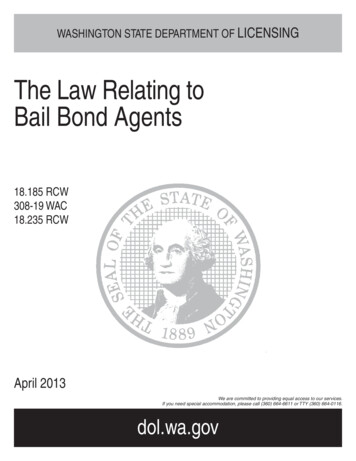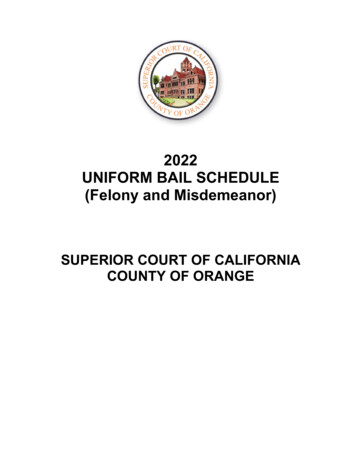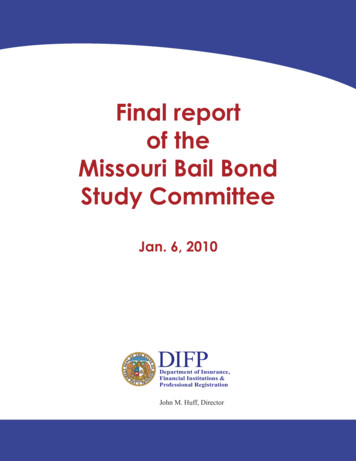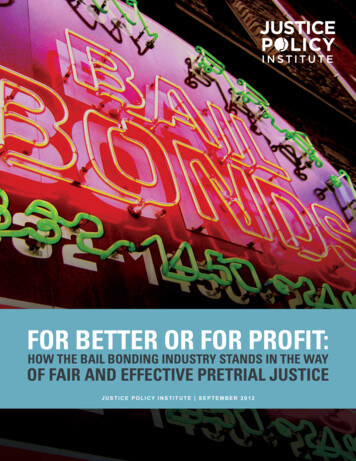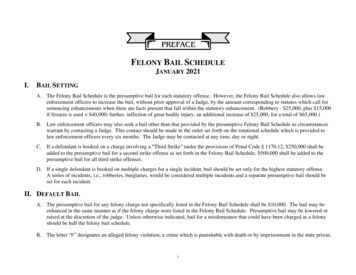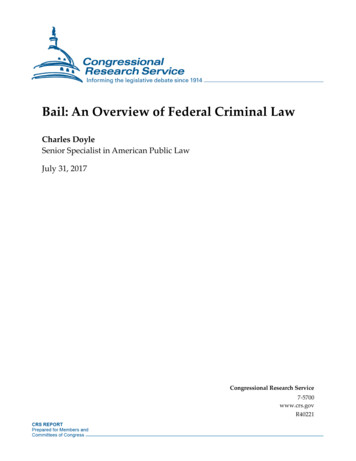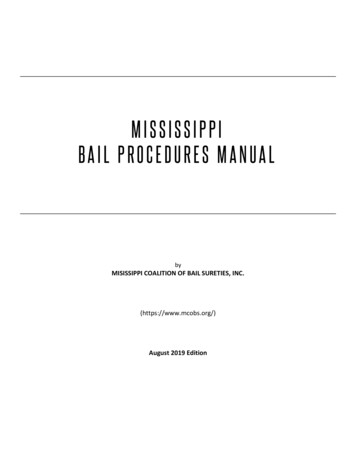
Transcription
BAIL FAIL:Why the U.S. Should Endthe Practice of USING Money for BaiLJUSTICE POLICY INSTITUTE SEPTEMBER 2012
2justice policy instituteCONTENTS3PART 1: INTRODUCTION5PART 2: BACKGROUND AND CONTEXT5The Justice Policy Instituteis a national organizationfocused on reducing the useof incarceration and the justicesystem and promoting policiesthat improve the well-being ofall people and communities.The pretrial system is a complex process to navigate.6The History of Pretrial Detention and Use of Bail8The General Pretrial Process10PART 3: THE USE OF MONEY BAIL10The use of financial release has increased over the past years.10The amount of money bail set for defendants’ release has risen.13 The use of money in the pretrial process disproportionatelyimpacts vulnerable communities.17PART 4: Money Bail Effects on the Judicial Process17 Money bail keeps people in jail when they otherwise could safelyremain in the community while awaiting trial.2021Special Feature: Travis AlstonMoney bail does not increase community safety.24 Money bail poses adverse risks to those who have been chargedwith offenses.27PART 5: Effective Alternatives to Money Bail27 There are alternatives to money bail that improve outcomes forpeople awaiting trial and the community.28Special Feature: Tyriel Simms35 Measures of pretrial detention should be implemented to providenational measurements of our pretrial processes and drivepretrial reform efforts.1012 14th Street, NW, Suite 400Washington, DC 20005TEL (202) 558-7974FAX (202) 558-79783640Special Feature: Darian WatsonPART 6: Recommendations41WWW.JUSTICEPOLICY.ORG46 EndnotesSpecial Feature: Spurgeon Kennedy
“What has been demonstrated here is that usually only one factordetermines whether a defendant stays in jail before he comes to trial. Thatfactor is not guilt or innocence. It is not the nature of the crime. It is notthe character of the defendant. That factor is, simply, money. How muchmoney does the defendant have?”—U.S. Attorney General Robert Kennedy1BAIL FAIL:Why the U.S. Should Endthe Practice of USING Money for BaiLJUSTICE POLICY INSTITUTE SEPTEMBER 2012
2justice policy instituteMoney determinespretrial release for7 outof 10people accused of felonies.
B A IL FA ILpart 1IntroductionThe vaguely understood pretrial process of bail costs the taxpayers of theUnited States billions of dollars and infringes on the liberty and rights ofmillions of Americans each year.Fortunately, there are alternatives that states andcourt dates was costing counties, alone, around 9localities can pursue that have been shown tobillion a year.2effectively promote safety, deliver justice, anddecrease the number of people in jails all whilereducing the price of this incarceration to taxpayers and those directly impacted.The use of bail money is generally accepted forsecuring release from jail after an arrest. It is a partof our culture: there are jokes about getting bailmoney if one anticipates getting into trouble and aNumerous reports and studies have supported thevery common fundraiser involves donating dollarselimination of money bail since the early 1900’s;in order to “bail out” a person raising money forhowever, reform efforts have been slow. With thea cause. However what is not well known is thatera of mass incarceration putting the United Statesstarting at the time of arrest, many people chargedat the top of the world regarding the number of itswith an offense undergo a confusing, coercive,residents behind bars, the need for reform has be-and expensive process intended to deliver justice.come increasingly urgent. States that cannot main-Constitutional safeguards, court rulings, and lawstain burgeoning criminal justice systems are nowprovide for both the protection of people who areopen to safer, more effective ideas.accused of offenses, as well as, the power of gov-Current policies and practices around money bailare among the primary drivers of growth in ourjail populations. On any given day, 60 percent ofthe U.S. jail population is composed of people whoare not convicted but are being held in detentionas they await the resolution of their charge. Thisernment to pursue justice and safety in the community. However, the extensive use of money bailas the primary release mechanism has distorted thepretrial justice process. While cases are resolved,justice is not always served and our communitiesare not always safer.time in detention hinders them from taking care ofHowever, the ability to pay money bail is neithertheir families, jobs and communities while over-an indicator of a defendant’s guilt nor an indicatorcrowding jails and creating unsustainable budgets.of risk in release. The focus on money alone as aIn 2011, detaining people in county jails until theirmechanism for pretrial release means people often3
4justice policy instituteare not properly screened for more rational mea- Discussion of issues involved in the use ofsures of public safety risk: their propensity to fleemoney bail, such as disproportionate impactbefore their court date or their risk of causing publicon certain communities, loss of liberty, and itsharm. Meanwhile, those too poor to pay a moneylinkage to the practice of plea-bargaining.bail remain in jail regardless of their risk level orpresumed innocence. Evidence suggests that up practices to give readers an idea of what couldto 25 percent more people could be safely releasedbe done instead of depending on money bail.from U.S. jails while awaiting trial if the properprocedures are put in place,3 including valid risk assessments and appropriate community supervision.Overview of more effective, just, and cost-saving Recommendations for beginning to practicallyaddress the issue of money bail.This report provides an explanation and analysis ofThere are vastly more effective and cost-savingthe use of money bail in the pretrial justice system.practices that should replace money bail as our pri-The following sections are designed to facilitatemary release mechanism. By implementing moremeaningful discussion and reform:effective and efficient programs and services, vari- Overview of the pretrial process so thatous jurisdictions across the U.S. are demonstratingeven readers with little to no familiaritythe cost savings and enhancement of communitywith the process can understand what maysafety that could be gained.happen from arrest through a chargebeing resolved.
B A IL FA ILpart 2Background AND CONTEXTBetween June 2010 and June 2011, about 11.8 million people were processedthrough jails across the United States. At midyear 2011, the total U.S. jailpopulation was 735,601 people. U.S. jails have operated at an average of 91percent capacity since the year 2000, resulting in a huge financial burden tostates, cities, and counties.4Since 2005, a majority of people held in jail havemore than a majority waited 51 days or more). Me-not been convicted of the offense for which they aredian waits ranged from 31 days for forgery to morecharged: approximately 60 percent of people in jailsthan 150 days for rape charges.6are merely awaiting trial or are in the trial processfor the offense in question.5The Fifth, Sixth, and Fourteenth Amendmentsprovide the constitutional basis for the legalprinciple commonly referred to as “innocent until proven guilty,” which is a critical safeguardwithin our criminal justice system. The Sixth andFourteenth Amendments, along with many courtrulings since their passage, also provide guidancefor if, when, and how long, courts may order thedetainment of an accused individual. The EighthAmendment of the U.S. Constitution providesthat bail not be excessive for people accused ofoffenses. These protections are in place so that thecourts may adequately examine a person’s guiltor innocence, while also safeguarding the person’slife and liberty.The pretrial systemis a complex processto navigate.What pretrial process a person will go throughdepends on the state and jurisdiction in which heor she is arrested. The United States Constitution’sFifth Amendment affirms that people cannot bedeprived of their liberty without due process oflaw. However, states and jurisdictions have varying laws on detainment for capital offense charges,consideration of safety, and requirements aroundimposing the least restrictive bail conditions. TheAmerican Bar Association and the National Association of Pretrial Service Agencies have providedstandards to guide pretrial activities; however, atThere are no national data regarding how longthis time, many practices do not yet comply withpeople stay in jail until their case is resolved; how-these recommendations.ever, in the 75 most populous counties, peopleaccused of felonies who did not post bail in 2002waited a median of 51 days in jail until trial (that is,Summons and Citations: In some jurisdictions, law enforcement has the option to dispense5
6 justice policy instituteThe History of PretrialDetention and Use of BailThe use of pretrial detention and bail in motivating appearance at courthearings has an extensive history.As early as 1275, officials in England were debating and curtailing the use of pretrial detention andbail. The use of bail carried over from England into the U.S.; however, initial laws greatly limited theuse of pretrial detention and excessive bail. The role of the for-profit bail industry began in the UnitedStates in the 1800’s primarily due to the lack of large family or community ties as well as large areaswhere a defendant could flee during the settling of the country.However, as early as 1920, critiques of the bail system’s use of for-profit bail bonding companiesemerged and called for alternatives to surety bonds. Even then, the bail bonding system was criticized as it “neither guarantees security to society nor safeguards the right of the accused.” Recommendations were made for the use of citations rather than arrests and systematic “fact-finding” indetermining bail for the accused. In 1954, reports began to show that an increasing majority of peopledetained while awaiting trial were of low income; these observations paved the way for pilot programs, such as the Manhattan Bail Project, testing the use of Release-On-Recognizance and otherforms of pretrial release.Due largely to reform efforts, the Bail Reform Act of 1966 was passed which created a foundation forreducing dependence on money bail and increasing the use of nonfinancial release options. The BailReform Act of 1984, a component of a larger Comprehensive Crime Control Act of 1984, added theconsideration of safety in the community as a factor in pretrial release decisions. Challenges to this Actwere defeated in United States v. Salerno, in which the Supreme Court concluded that the protectionthe Act provided did not violate Constitutional rights as long as detention was not applied excessive.Since the 1970s, various states and jurisdictions have worked to improve the pretrial process throughvarious programs and pilots; meanwhile, the for-profit bail bonding industry has continued its efforts tokeep for-profit bail companies a part of the judicial system.Timothy R. Schnacke, and others, “The History of Bail and Pretrial Release,” Pretrial Justice Institute, September 2010.
B A IL FA ILcitations or summons for certain charges in ordercourts may detain people charged with a particularto reduce the number of arrests and lessen the bur-offense of interest to the state, with prior convic-den on the local jail to process people charged oftion history, and/or having the status as an un-offenses. The process from arrest to charge resolu-documented immigrant. About 21 states have lawstion generally proceeds as shown in the flow chartdisallowing the detainment of people for charges“The General Pretrial Process”; however, the spe-other than capital offenses, and at least two states—cifics and requirements involved will vary amongAlaska and Tennessee—do not allow courts to denyjurisdictions.bail even for capital offenses.8Upon Arrest: Depending on the potential orRelease on Bail: There are several ways a per-actual charge and the jurisdiction, a person may beson may be released after their arrest as they awaitreleased from the police station after having theirtheir court date.charge processed and bail set there. Others mayhave to go through a booking at a jail prior to having bail set. Booking typically involves paperworkRelease options that do not involve money upfront: Release on recognizance—The person signs ato collect personal information, details about thecontract agreeing to appear in court for theirarrest and charge, and, in some jurisdictions, fin-hearing as required.gerprinting and a photograph. Usually, the accusedperson is then held in detention until appearing Unsecured bond—The person signs a con-before a judicial officer or a judge to have the con-tract agreeing to appear in court for theirditions of their release set.hearings and accepting liability for a setamount of money should they not appear inBail Setting: The Supreme Court has affirmedcourt as required.that people have the right to counsel at the bailsetting before a judicial officer; 7 however, this is Conditional release—The person is given a listnot provided in most jurisdictions. In some places,of stipulations that must be honored in ordera second bail hearing or review will be held veryto remain out of jail while awaiting trial. Thesesoon after the first bail determination where theoften include drug and alcohol use screenings,original decision of whether to grant bail and howorders to attend mental or substance abuse dis-much can be reviewed by the judge; counsel fororder treatment, and/or monitoring by a thirdthe defendant is required at this hearing in someparty, such as a family member, pretrial serviceplaces. In other places, only if a person requests itagency, or others.will they get a second bail hearing. Release to pretrial services—Where available,Bail Denied: In accordance to the laws of thesomeone may be required to be supervised byjurisdictions, judicial officials may deny bail toa pretrial services agency. These organizationsprevent the pretrial release of people accused oftypically conduct risk assessments and providecertain offenses. In accordance to the Bail Reformthe appropriate supervision as indicated byAct of 1984, most states allow for bail to be deniedrisk assessment findings.for capital offenses, which are crimes punishableby death. Around 28 states have laws that allowfor bail to be denied for charges other than capitaloffenses with rationales that vary greatly. Often7
8justice policy instituteTHE GENERAL PRETRIAL PROCESSSUMMONSArrestCITATIONBOOKING/LOCK-UPBAIL SETBAIL DENIEDJAILCash BondSurety BondConditional ReleaseDeposit BondRelease to Pretrial ServicesProperty BondUnsecured BodReleased On RecognizanceUNABLE TOPAY BAILREMAIN IN JAILCOURT HEARINGPLEABARGAINFAILURE TO APPEARRE-ARRESTJAILCOURT HEARINGCHARGE RESOLVEDPLEABARGAIN
B A IL FA ILRelease options that require money in order to getHeld on Bail: When a bail is assigned that re-out of jail pretrial:quires money upfront, people who are unable to Cash bond—The person (or their friends andfamily) pays the bail amount in full in orderto be released from jail. Upon return to court, plea bargain).The general pretrial process is described in the fol-ministrator’s or other court fees). Some juris-lowing flow chart. However, each jurisdiction willdictions allow cash bail to be paid with a creditdiffer in the specifics of how the process will pro-card; others forbid this.ceed; therefore, this chart is only intended as a gen-Deposit bond—The person pays a percentagethe understanding that failing to appear tocourt will make them liable for the full bailamount. This percentage usually is required inthe form of cash or a payer’s check.Commercial bail bond—Also known as asurety bond, the person (or their friends andfamily) gets a bail bondsman (a private citizenworking for a for-profit bail bonding company)to sign a promissory note to the court for thefull bond amount. They are required to pay thebondsman a non-refundable fee that is typically 10% of the bond amount. Depending onthe bondsman, some people will be requiredto put up collateral as well (such as a vehicle,home, etc.). ing or the charge is resolved (usually through athey will be reimbursed this money (less ad-of the bail amount (usually 10 percent) with pay are “held on bail” in jail until their court hear-Property bond—In lieu of cash, the person mayprovide a deed and other paperwork to allowthe courts to put a lien on a property for the value of the bond amount. Until the person appearsin court, the court holds the deed on a house ortitle to other property such as a boat or car.Sometimes, judges or court representatives will mixthe release options. A person may be required tosign for an unsecured bond and abide under certain conditions to be released. In other situations,judges will require that a person post a moneybond while also remaining under supervision ofpretrial service agencies.eral explanation of the steps a typical person mayencounter from arrest until their charge is resolvedthrough acquittal, having charges dropped,or conviction.9
10justice policy institutepart 3The Use of Money BailAccording to the most recently released State Court Processing Statistics data,the proportion of people charged with a felony who were granted nonfinancialrelease declined by 32 percent from 1992 to 2006; at the same time, financialrelease, primarily through commercial bonds, increased by 32 percent.The use of financialrelease has increasedover the past years.for those detained until their hearing more thanRelease on recognizance was the most commonlation affected by these increasing bail assignments.type of pretrial release in 1992; however, its usehad declined by 33 percent by 2006. Overall, 70percent of people charged with a felony were assigned money bail in 2006. The proportion of people detained pretrial increased by about 14 percentto a high of 42 percent of all those charged withfelonies in 2006 (only 5 percent of these were heldwithout bail).9The amount of moneybail set for defendants’release has risen.doubled from an average bail of 40,000 in 1992 to 90,000 in 2006.Median bail amounts show the extent of the popuIn 2006, the total population had a median bailamount of 10,000 which means that at least halfof felony defendants are assigned a minimum of 10,000 in bail. The average bail amount nearlydoubled between 1992 and 2006 from an amountof 25,400 to 55,500. Among people released, theaverage bail amount increased from 7,800 in 1992to 17,100 in 2006. Of defendants remaining in jailor prison pretrial, 50% percent had a bail amount of 40,000 or more in 2006. Since 2000, the median bailamount for those detained has been 25,000, upfrom 10,000 in 1992.The proportion of felony cases assigned bail under 5,000 decreased by nearly 15 percentage pointsA Bureau of Justice Statistics survey of felonyfrom 1998 to 2006; and the percent of cases withcases in the 75 most populous counties of the U.S.amounts from 5,000 to 24,999 has remained rela-showed that average bail amounts have increasedtively stable.by over 30,000 between 1992 and 2006,10 posing aserious concern for indigent populations involvedMeanwhile, more cases are receiving very high bailin the criminal justice system. Average amountsamounts. For example, in 1998, 25 percent of cases
B A IL FA ILDefendents released on nonfinancial bail prior to trial declinedas those detained on financial bail increased.50%Percent of felony ed200020022004Financial Release2006Nonfinancial ReleaseSource: State Court Processing Statistics data as retrieved from the Felony Defendants in Large Urban Counties reports, 1992 – 2006.Between 1992 and 2006, the median bail amountfor those detained increased by 15,000.25,000Median Bail Amounts ( 00020022004ReleasedSource: State Court Processing Statistics data as retrieved from the Felony Defendants in Large Urban Counties reports, 1992 – 2006.200611
justice policy instituteCases with bail amounts under 5,000 have dropped since 1998.35Proportion of cases30252015199419961998200020022004 5,000 - 9,999Under 5,000 10,000 - 24,999Source: State Court Processing Statistics data as retrieved from the Felony Defendants in Large Urban Counties reports, 1992 – 2006.An increasing number of cases are assigned high bail amounts.40%35%30%Percentage of cases1225%20%15%10%5%019941996 25,000 or more19982000 25,000 - 49,99920022004 50,000 or moreSource: State Court Processing Statistics data as retrieved from the Felony Defendants in Large Urban Counties reports, 1992 – 2006.
B A IL FA ILwere assigned a bail amount of 25,000 or more;pretrial.14 The use of money bail puts people with-yet, in 2004, 23 percent received a bail amount ofout expendable income at risk of suffering the ad- 50,000 or more. These increasing bail amountsverse impacts of detention in their cases.suggest that bail inflation has occurred along withan increase in the use of surety bonds involvingthe for-profit bail bonding industry. This meansthat the amount of money that bondmen can collect has increased along with the rise in money bailamounts. Overall, whereas 25 percent had a bailamount of 25,000 or more in 1998, this numberincreased to 37 percent by 2004.People who are able to put together enough moneyto post bail or pay a bail bondsman’s fee maydeplete their funds and the funds of families andfriends are that is needed to pay rent, buy groceries, and cover other bills.15 People who are unableto pay their money bail (or a bond for a portionof the bail) and remain in jail may lose their jobs,default on vehicles, lose their homes, get behind onNot only do high bail amounts pose a threat to consti-child support payments, lose custody of dependenttutional rights to liberty pretrial, but they are believedchildren, and more. The implications can make orto put low income populations at a disadvantagebreak a person’s ability to resume life after theirwhen facing plea bargains: people may feel pres-case is resolved.11sured to plead guilty as remaining in jail has suchsignificant negative consequences, such as losing ajob or not being available to take care of a dependent.“The requirement that virtually everydefendant must post [money] bail imposes personal hardship on them,Whereas the Bail Reform Act mandates that peopletheir families, and on the public whichbe released to the “least restrictive” conditions thatmust bear the cost of their detentionwill also assure appearance at trial and the safety ofand frequently support their depen-the community, many are not able to access thosedants on welfare.”least restrictive conditions due to an inability to paybail. The role of finances in this equation not onlyviolates the mandates of the Bail Reform Act but alsois believed to violate the Equal Protection Clause.12— American Bar Association, StandardsRelating to Pretrial Release, 196816For all intents and purposes, those held in jail areset up to fail, even if they are innocent of the charge.The use of money inthe pretrial processdisproportionatelyimpacts vulnerablecommunities.When held in jail, a person is not able dress as pre-Many studies have shown over the years thatto limited phone use, obligations to work long shiftspeople held in jail pretrial end up with worse trialin jail programs,19 placement in jails long distancesoutcomes than people who are free while awaitingaway from their counsel,20 and other reasons.trial. Those held pretrial are more likely to be convicted of a felony,13 receive a sentence of incarceration, and be sentenced longer than those releasedsentably as one who is able to come from their ownhome dressed and prepared.17 Jurors who see defendants in jail uniforms and shackles may be biasedas being in jail is equated to dangerousness andguilt.18 They are not able to work with their counsel to prepare their defense, gather witnesses, andother activities needed to present a strong case duePeople held in jail pretrial may lose their job dueto absence;21 and if they are self-employed, pretrial13
14justice policy institutedetention effectively shuts their business down.matters should be available to all people awaitingNot only does the lack of income impact the indi-their court date, keeping within the parametersvidual, their family, and their communities, butof safety but not requiring they have financial re-the collective amount of lost income due to pretrialsources to do so.detention can amount to millions of dollars andimpact a country’s economy. A number of studieshave shown the loss of income in other countriesdue to pretrial detention: In Mexico, 100 milliondollars of income was lost to pretrial detentionin 2006.22 In Argentina, over 10 million dollarsof income is lost to pretrial detention each year.23Similar information about income loss in the U.S.are not available, but considering that thousandsof people are held pretrial throughout the year, theloss of income is likely to be significant.Pretrial detention causes some people to lose theirhome, apartment, or spot in a shelter.24 They may“The argument that Madoff andDreier had a fundamental right to theextensive conditions they receivedignores the fact that such conditionsare unavailable and unrealistic forthe broader population. Rather, theseextensive conditions represent specialprivilege, and there is no fundamentalright to pay for preferential treatmentin the criminal justice system.”— Jonathan Zweig, Harvard Journalon Legislation28suffer a disruption in their medical care as providedThe question of whether money bail leads to viola-by Medicaid and may even lose their health insur-tions of the Equal Protection Clause of the Four-ance due to being in jail.25 Their families are oftenteenth Amendment has been raised. The Equaladversely impacted, as their children may have toProtection Clause provides that laws are to be car-move to another parent or relative’s home, sufferingried out in a way that does not differ between peo-disruptions in their education and home life, as wellple in similar situations.29 Accordingly, a number ofas the trauma of having an incarcerated parent.26court decisions have agreed that a person shouldIn addition to the use of money bail, people withfinancial resources are currently able to pay “forextensive conditions of release” that would otherwise not be permissible.27 One commentator notedthe expensive conditions for pretrial release thatBernard Madoff and Marc Dreier were able to payfor in order to avoid pretrial detention for chargesof financial “white collar” crime. In addition tobeing able to post a bond for their bail, they paidfor security, video monitoring, and other restrictions in order to remain in their homes and attendto business while awaiting trial. In addition to theuse of money to pay bail, this expanded use ofmoney to pay for conditional requirements widensthe gap between defendants who have money andthose who do not. The ability to maintain one’sjob, housing, caregiver responsibilities, and othernot be incarcerated on the basis of wealth, but allshould have equal treatment and constitutionalaccess to their fundamental rights under the lawwithout regard to their financial status. However,the use of money bail with populations that do nothave access to financial resources resultsin very different treatment compared tothose who can affordto post a bond. Although an upper middle class person anda low-income personmay be arrested andcharged with the sameoffense, the uppermiddle class personThe averagebail amount fordetained peoplehas increased from 39,800 in 1992 to 89,900in 2006.
B A IL FA ILis much more likely to be able to post a bond andand sentencing decisions, racial disparities in themight even be able to secure a release on the samepretrial process have a ripple effect throughoutday. Meanwhile, the low-income person remainsthe justice system. The U.S. Supreme Court hasin jail because he cannot pay a bond—regardlessaffirmed the pretrial process as “perhaps the mostof the fact that the offense charge was exactly thecritical period of the proceedings”,32 so the impactsame as his released counterpart’s and regardlessof race on decisions during this time is of particularof his presumed innocence.importance. Previous studies have shown differing results when trying to find a direct relationshipDue to disparities in the pretrialprocess, African American andLatino populations are moreimpacted by the use of money bail.between race and pretrial decisions. However, aApproximately 11.8 million people were processedence pretrial decisions and outcomes. The studythrough jails during 2011; the total jailed popula-revealed correlations between race and all pretrialtion at a single point in time (midyear) was 736,000outcomes analyzed, concluding that “each correla-people. Annual jail populations show that a high-tion indicated harsher treatment for African Ameri-er number of white people are in jail; however, con-cans.”33 The results showed that:30sidering that the black population only comprises13 percent of the total U.S. population, it is disturb-recent study looked at how race affects extralegalfactors, such as education and financial support,which then affect legal factors, such as prior recordand severity of charge. Together these factors influ- leased on their own recognizance than whiteing that they comprised 38 percent of the U.S. jaildefendants.34population in 2012. Estimates show that the rateof Black/African American people being detainedin jail was nearly 5 times higher than white and 3times higher than Hispanic people.31Disparities in jail populations have persisted despite years of studies on race and pretrial decisions.Since being jailed while awaiting tria
The role of the for-profit bail industry began in the United States in the 1800's primarily due to the lack of large family or community ties as well as large areas where a defendant could flee during the settling of the country. However, as early as 1920, critiques of the bail system's use of for-profit bail bonding companies


